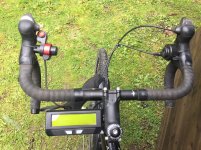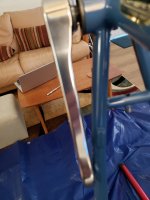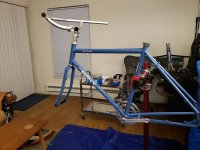RunForTheHills
1 kW
Hi, I have been lurking here for a few days. I have been thinking about getting an electric bike. However, most of the prebuilt e-bikes I looked at don't really appeal to me with the oversized tubing and suspensions. I am new to e-bikes, but I have the tools and I am comfortable working on and building regular bicycles.
I don't intend to ride the bike faster than 20 MPH. I am 5'8", weigh around 170 lbs, and ride on a 52cm road frame (29.5" inseam). I am in my mid 50's and getting slower. I run for exercise and ride for fun. I mostly ride a very short commute to work, but I change jobs a lot (IT contractor) and my commute changes frequently. I love my Surly LHT that I use to commute to work. Maybe I am underestimating the value of a front suspension, but I don't have a problem getting up on the pedals to absorb bumps on my LHT. I ordered a Surly Disc Trucker frame and intend to build it into an e-bike. I am considering the following components for the build. I thought I would post it here and see if anyone has suggestions to improve it. The only thing I have ordered so far is the frame. If it doesn't work out as an e-bike, I have been wanting to build an upright Trucker anyway. The only downside of starting it as an e-bike (other than the cost) is that I have to drill a hole in the bottom bracket for the torque sensor, but I don't think that will compromise the integrity of the frame. I plan to mount the battery to the water bottle bosses (strong enough?) and the controller to the rack.
From Ebikes.ca:
1. Ezee 250RC motor laced into a 26" wheel w/11-34 10 speed cassette (will be 1X10 with a 44 tooth chainring)
2. Phaserunner Controller
3. Cycle Analyst CA3-DPS
4. Handlebar Mounted Auxilliary Potentiometer
5. Sempu Torque Sensor with 115mm Spindle
6. Thumb Throttle
7. Ebrake Cutoff Sensor (Tripwire Push?)
8. GRIN Universal Rear Torque Arm
9. 52V Satiator Charger
10. 3mm and 5mm Stainless Steel washer for spacing hub motor axles (not sure what is needed for 10 speed cassette)
11. Stainless Steel Mounting Plate for Attaching CA to Bicycle Steer Tube
12. Velcro Strechy Sleeve to cover wires and connectors
From EM3EV
1. 52V (14S5P) EM3ev Jumbo Shark 17.0 AH
I am still trying to nail down the rest of the build, but these are some of the other components I am considering:
1. Nitto North Road Bars (My current LHT is a drop bar, but I want to try an upright position. I will probably get an adjustable stem to figure out what I need and then order a fixed stem)
2. Chris King Sotto Voce 1 1/8" NoThreadSet Headset - Silver
3. Nitto S65 (Crystal Fellow) Seatpost
4. Brooks B67 Saddle in Honey
5. Tubus Logo Classic Rack
6. B&M IQ-X headlight (e-bike version or run dynamo hub). It seems like a dynamo hub would have the advantage of working if the battery died.
7. B&M Toplight tail light
8. Shimano XT RD-M786-GS Shadow Direct Mount Rear Derailleur, Silver
9. Shimano SL-M780 XT 10-Speed Shifter
10. VO Grand Cru Fluted Single Crankset (44 Tooth)
11. VO 26" Smooth Fenders, 60mm
12. VO Alloy Chainguard
13. Hydraulic Disc Brakes (haven't decided which yet). I like the look of the TRP G-Spec Quadiem, but I don't like the price and they are way overkill for my application. I would prefer silver colored brakes for this build.
I don't intend to ride the bike faster than 20 MPH. I am 5'8", weigh around 170 lbs, and ride on a 52cm road frame (29.5" inseam). I am in my mid 50's and getting slower. I run for exercise and ride for fun. I mostly ride a very short commute to work, but I change jobs a lot (IT contractor) and my commute changes frequently. I love my Surly LHT that I use to commute to work. Maybe I am underestimating the value of a front suspension, but I don't have a problem getting up on the pedals to absorb bumps on my LHT. I ordered a Surly Disc Trucker frame and intend to build it into an e-bike. I am considering the following components for the build. I thought I would post it here and see if anyone has suggestions to improve it. The only thing I have ordered so far is the frame. If it doesn't work out as an e-bike, I have been wanting to build an upright Trucker anyway. The only downside of starting it as an e-bike (other than the cost) is that I have to drill a hole in the bottom bracket for the torque sensor, but I don't think that will compromise the integrity of the frame. I plan to mount the battery to the water bottle bosses (strong enough?) and the controller to the rack.
From Ebikes.ca:
1. Ezee 250RC motor laced into a 26" wheel w/11-34 10 speed cassette (will be 1X10 with a 44 tooth chainring)
2. Phaserunner Controller
3. Cycle Analyst CA3-DPS
4. Handlebar Mounted Auxilliary Potentiometer
5. Sempu Torque Sensor with 115mm Spindle
6. Thumb Throttle
7. Ebrake Cutoff Sensor (Tripwire Push?)
8. GRIN Universal Rear Torque Arm
9. 52V Satiator Charger
10. 3mm and 5mm Stainless Steel washer for spacing hub motor axles (not sure what is needed for 10 speed cassette)
11. Stainless Steel Mounting Plate for Attaching CA to Bicycle Steer Tube
12. Velcro Strechy Sleeve to cover wires and connectors
From EM3EV
1. 52V (14S5P) EM3ev Jumbo Shark 17.0 AH
I am still trying to nail down the rest of the build, but these are some of the other components I am considering:
1. Nitto North Road Bars (My current LHT is a drop bar, but I want to try an upright position. I will probably get an adjustable stem to figure out what I need and then order a fixed stem)
2. Chris King Sotto Voce 1 1/8" NoThreadSet Headset - Silver
3. Nitto S65 (Crystal Fellow) Seatpost
4. Brooks B67 Saddle in Honey
5. Tubus Logo Classic Rack
6. B&M IQ-X headlight (e-bike version or run dynamo hub). It seems like a dynamo hub would have the advantage of working if the battery died.
7. B&M Toplight tail light
8. Shimano XT RD-M786-GS Shadow Direct Mount Rear Derailleur, Silver
9. Shimano SL-M780 XT 10-Speed Shifter
10. VO Grand Cru Fluted Single Crankset (44 Tooth)
11. VO 26" Smooth Fenders, 60mm
12. VO Alloy Chainguard
13. Hydraulic Disc Brakes (haven't decided which yet). I like the look of the TRP G-Spec Quadiem, but I don't like the price and they are way overkill for my application. I would prefer silver colored brakes for this build.








